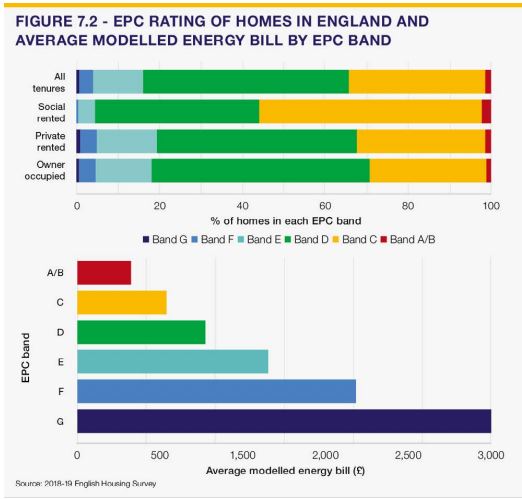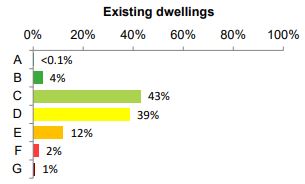Next Steps for Minimum Energy Efficiency Standards (MEES)

There has recently been some mixed/confusing reporting over the potential requirements for rented properties to meet a minimum EPC ratings. This blog is concerned with the policies on privately rented homes, and NOT privately rented non-domestic buildings.
The key take away is that the government has stated its intention in The Energy White Paper, published in Dec 2020 that they want “as many existing homes as possible to hit EPC Band C by 2035 where practical, cost-effective and affordable.”.
The 2020 consultation does set out a “preferred policy scenario” that the privately rented properties will require an EPC rating of C for “new tenancies from 1 April 2025 and all tenancies by 1 April 2028”. This is one of a number of different implementation scenarios discussed in the consultation.
A private members bill is making it’s way through Parliament (follow its progress here), with the 2nd reading scheduled for 18th March 2022 with the following requirements:
“(a) all new tenancies must have an energy efficiency performance of at least EPC Band C from 31 December 2025; and
(b) all existing tenancies must be at least EPC Band C from 31 December 2028 where practical, cost-effective and affordable as defined under
section 1(4). “
Section 1(4) specifies:
“The Secretary of State may by regulations define the terms “practical”, “cost-effective” and “affordable”. “
So, if the bill does become law (which it is not clear at this stage as it is a private members bill), the Secretary of State will have the power to define what is practical, cost effective, and affordable. Currently landlords are only expected to spend up to £3,500 per property to achieve a rating of E.
The consultation paper talks about a figure of £10,000 (inc vat) being a figure which would meet this criteria and expected that landlords would have up to seven years to plan and save for the works.
“Under proposals set out in this consultation our modelling indicates that on average, landlords will spend £4,700 per property to reach EPC C, if a maximum cap of £10,000 on the total investment on current prices (and inclusive of VAT) is set. This cost cap is the optimal level at which a majority of PRS properties would be improved to EPC Band C (~70%) whilst trying to limit expense for landlords (reflecting the CGS commitment that improvements should be cost effective and affordable).”
“In addition the development of a green home finance market would help landlords borrow money against the value of their assets in order to fund the energy performance improvements; this is something we are testing through our Green Home Finance Innovation Fund (42) and our planned consultation on the role of mortgage lenders in helping households improve energy performance of homes they lend to. Landlords are further encouraged to apply for vouchers under the Green Homes Grant scheme to fund at least two thirds of the cost of hiring tradespeople to upgrade the energy performance of their PRS properties up to a contribution of £5,000 when the scheme officially launches at the end of September.”
The problem here is that landlords won’t be inclined to spend any significant amounts on improving energy efficiency until they know what the affordability figure is, which won’t be until late on in the process or even after the bill becomes law if the power is to be retained by the Secretary of State, who may then change the affordability figure as they see fit in the future.
For now, it seems sensible for landlords to look at including improvements in energy efficiency when carrying out any works to their properties, wait and watch to see if the bill becomes law, and make some financial provisions in case it does.
History
August 2007: Energy Performance Certificates were introduced for England Wales.
April 2018: Landlords were no longer allowed to issue tenancies for properties that have an EPC rating of F or G unless exemptions apply, the main one being a cost cap of £3,500 (including VAT) which limits what landlords would be expected to spend to increase the energy efficiency of the property to band E.
April 2020: The minimum standard rating of E extends to all existing tenancies, not just new ones entered into, again, unless exemptions apply.
September 2020: The Government launched a consultation into ‘Improving the energy performance of privately rented homes.’ Read our blog on the consultation here.
July 2021: A private members bill, ‘The Minimum Energy Performance of Buildings‘ was introduced in the House of Commons by David Amess MP who was tragically murdered in October 2021 and has since been sponsored by Sir Roger Gale. The 2nd reading is scheduled for 18th March 2022.
The Numbers
 According to the latest UK Governments Statistics, 60% of all EPC lodgements (to the end of 2021) are rated D to G, of those, 21% are rated E-G.
According to the latest UK Governments Statistics, 60% of all EPC lodgements (to the end of 2021) are rated D to G, of those, 21% are rated E-G.
According to the ONS, there were 4.44m private rented households in England in 2020, so assuming that the distribution of energy performance ratings of rented properties is the same as owner occupied properties (a big stretch I know), 2.66m rental properties are currently rated less than C, and 932,000 of those are rated E or below.

